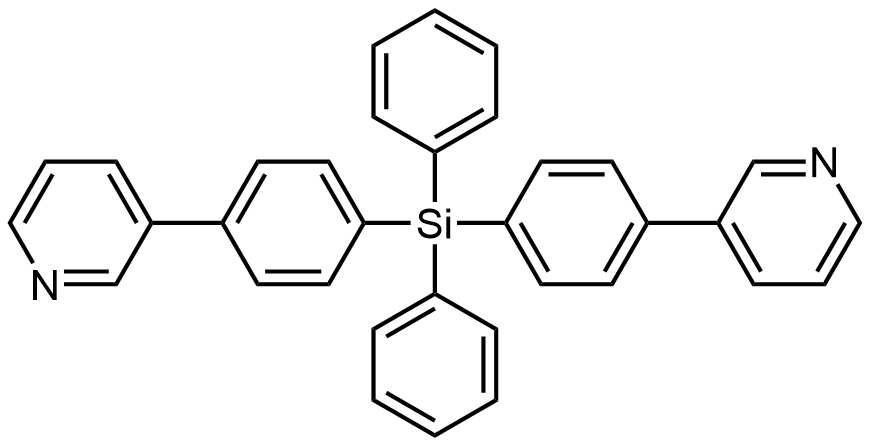The content on our website is provided solely for general informational purposes. It should not be considered, nor is it intended to provide advice or recommendations for the purchase, sale, or trade of any products or services. Importantly, the information presented does not constitute an offer to sell or a solicitation of an offer to buy any product.
Please be aware that the availability of our products may vary across different markets due to regulatory restrictions or other considerations. Consequently, not all products or services may be available in your region or country. For specific inquiries regarding the availability and pricing of any product, please contact us at sales@noctiluca.eu.
General information
-
Name:
DPPS
-
Full name:
Diphenyl-bis(4-(pyridin-3-yl)phenyl)silane
-
CAS number:
1152162-74-7
-
Chemical formula:
C34H26N2Si
-
Molecular weight:
490.67 g/mol
-
Absorption:
λmax = 251 nm in DCM
-
Photoluminescence:
λmax = 366 nm in DCM
-
HOMO/LUMO:
HOMO = 6.5 eV, LUMO = 2.5 eV
-
Synonyms:
3,3'-[(Diphenylsilylene)di-4,1-phenylene]bispyridine
-
Classification:
Organic light-emitting diodes, Hole blocking layer materials (HBL), Electron transport layer materials (ETL), TADF materials
-
Purity:
Sublimed: >99.0% (HPLC)
-
Melting point:
TGA: >250 °C
-
Appearance:
White powder/crystals
DPPS: Pioneering OLED Efficiency and Stability
DPPS, or Diphenyl-bis(4-(pyridin-3-yl)phenyl)silane, with its CAS number 1152162-74-7, marks a significant advancement in the domain of organic light-emitting diodes (OLEDs). Characterized by its chemical formula C34H26N2Si, DPPS is a crucial component in the architecture of OLED devices, serving as a versatile material in hole blocking layer (HBL) and electron transport layer (ETL) applications, as well as in thermally activated delayed fluorescence (TADF) technologies. The exceptional electronic properties of DPPS, evidenced by a HOMO level of 6.5 eV and LUMO of 2.5 eV, underscore its utility in enhancing device performance and energy efficiency.
The Molecular Structure and Properties of DPPS
DPPS, through its molecular architecture featuring phenyl and pyridyl ligands coordinated around a central silicon atom, is meticulously engineered to enhance OLED device performance. This configuration enables optimized electron transport and effective hole blocking, essential for the stability and photonic efficiency of OLED systems. The precise alignment of its electronic states, with a HOMO of 6.5 eV and LUMO of 2.5 eV, ensures seamless integration into the active layers of OLED devices, promoting enhanced luminance, color purity, and device longevity. Moreover, the sublimation purity of DPPS, exceeding 99.0% as confirmed by High-Performance Liquid Chromatography (HPLC), attests to our rigorous quality standards. This level of purity is critical in reducing the incidence of non-radiative recombination sites, thereby augmenting the electroluminescent efficiency and operational durability of OLED displays. The strategic molecular design and exceptional purity of DPPS underscore its vital role in the advancement of OLED technologies, facilitating the development of displays that offer superior brightness, enhanced color spectrum, and extended lifespan.
Key Features of DPPS
- Enhanced Electron Transport and Hole Blocking: DPPS stands out for its dual function in OLEDs, improving electron transport and providing effective hole blocking. These capabilities are crucial for OLED efficiency, contributing to higher device performance and energy savings.
- Versatility in OLED Fabrication: The adaptability of DPPS across OLED technologies underscores its value. From TADF to ETL and HBL applications, DPPS’s flexibility facilitates innovative OLED development, making it a cornerstone in the creation of advanced display technologies.
- Superior Purity for Optimal Performance: DPPS is supplied with a purity exceeding 99.0%, as rigorously verified through HPLC analysis. This exceptional level of purity is crucial for minimizing impurities that can affect the performance of OLED devices, ensuring that each application of DPPS contributes to the creation of displays with unparalleled efficiency and clarity. Noctiluca’s commitment to such high standards of material purity underscores our role as a trusted partner in the OLED materials sector, facilitating the advancement of display technology with reliable and high-quality compounds.
The Role of DPPS in Advanced OLEDs
DPPS serves as a key innovator in OLED development, crucially enhancing device efficiency, visual quality, and energy savings. Its role in TADF and phosphorescent materials significantly boosts light emission, yielding OLED displays with enhanced brightness and richer color saturation. This function not only propels OLED technology forward by offering more vibrant and energy-efficient displays but also improves the longevity and performance of devices. The incorporation of DPPS into OLED structures demonstrates Noctiluca’s commitment to advancing display technology through the development of materials that support sustainable and high-quality visual experiences.
Conclusion
DPPS embodies Noctiluca’s dedication to leading the field of OLED material science, offering state-of-the-art solutions tailored to meet the dynamic needs of modern OLED technology. Our proficiency in providing high-purity DPPS, coupled with our extensive capabilities in chemical manufacturing and research, firmly establishes us as a pivotal ally in the OLED sector’s journey toward groundbreaking and eco-friendly display innovations. By fostering advancements in TADF materials and electron transport layer (ETL) applications, we are not just suppliers but partners in the quest for superior, energy-efficient OLED displays. This collaboration underscores our role in pushing the boundaries of what’s possible in OLED technology, ensuring our contributions lead to displays that set new standards for performance and sustainability in the industry.
